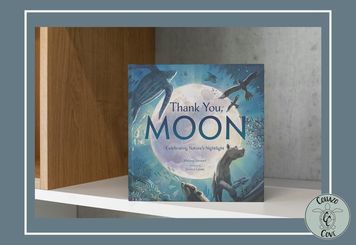|
If you follow me on Twitter (X), you probably know that Melissa Stewart is one of my favorite picture book authors because her ability to convey non-fiction in simple, yet beautiful language is phenomenal! This post features her book THANK YOU, MOON: Celebrating Nature’s Nightlight which is illustrated by Jessica Lanan. As a beautiful “thank you note” is conveyed on the left-hand pages, the right side shares interesting, related facts about our moon written in kid-friendly language. The facts are fascinating because they all focus on creatures (land and sea) that depend on the moon for their survival. Featured Picture Book:
Thank You, Moon: Celebrating Nature’s Nightlight (2023) By Melissa Stewart Illustrated by Jessica Lanan Summary (via Amazon): With the soothing rhythm of a bedtime story and the scientific wonder of a nature doc, comes a celebration of the moon and all the creatures who rely on its light to find their way home. Under the glow of a shimmering moon, creatures great and small creep out of their dens, using its light to hunt, fend off predators, build their nests or build families. As the moon changes phases these animals adapt their behavior to match its waxing and waning—while human animals look on in wonder. As Earth's closest companion in space, the moon has fascinated humankind for generations, and this nonfiction picture book sheds light on the mysterious ways it affects life on Earth. With luminous illustrations by Jessica Lanan and a lyrical text that is part lullaby and part scientific resource, Thank You, Moon is a treasure for all ages to enjoy. Related Themes and Standards: Science:
SEL:
STEM Ideas: 1. Have students choose one of the creatures mentioned in the story (there are even more facts about each one in the book’s back matter) and create a virtual habitat or build one with recyclable materials. 2. Have students create a video featuring further research about one of the creatures mentioned in the story. 3. Have students write their own thank-you notes to the moon, then engineer a rover that could deliver it from its landing module. If you have access to drones, create a mission where the drones have to deliver the message to a particular place on a mock lunar surface. 4. Use Beebots or other robots to create a more engaging Moon Phases card sort activity. I used this free download and made two laminated sets for each “team”. They had to program their robot to move to the moon phase on the mat that matched the one they selected from their deck. So many grade levels study our beautiful moon! Feel free to add your favorite lunar activity in the comments! #BetterTogether
0 Comments
Leave a Reply. |
Kim CollazoSTEM Advocate and Picture Book Author Archives
April 2024
Categories
All
|


 RSS Feed
RSS Feed